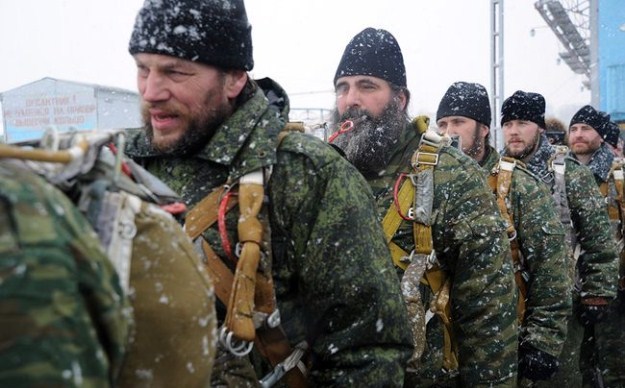 by Alina Lobzina
by Alina Lobzina
A squad of Orthodox paratrooping priests is fully prepared to help the Russian army in conflict zones after a special training session held in March.
For the first time, all priests currently serving with the airborne forces got together for some parachuting exercises and work discussions with their more experienced colleagues.
“Many of our batyushki [priests] have been awarded medals, some have served in Chechnya and Kosovo,” Archpriest Mikhail told The Moscow News.
First time skydiving
Some of the bearded spiritual servicemen had never skydived before, and the military training in the Ryazan Institute for Military Paratroopers provided them with the opportunity to make amends for this.
“How can I bless someone before a parachute jump if I’ve never done it myself?”
Alexander Tsyganov from the Church of Alexander Nevsky in Pskov told The Moscow News.
The 20-something man became a priest one month after finishing his military duty in November last year and felt he had no other choice but to return to the army.
 Together with 15 other priests at the training session, he was appointed to serve in the airborne forces and had to take this new position.
Together with 15 other priests at the training session, he was appointed to serve in the airborne forces and had to take this new position.
Parachuting church
Unfortunately, the weather conditions in Ryazan didn’t allow for the testing of the world’s only parachuting church, as representatives of the Defense Ministry call an army tent filled with unbreakable items for Orthodox services.
The church, complete with an air conditioner, a power generator and a multimedia unit, has very little in common with well maintained Moscow churches – posters of saints replace the usual gilded ornaments here.
“I don’t know why people think it’s a novelty – we had the same church in Kosovo in 1999,”
Mikhail said while other priests were preparing their parachutes for jumping exercises.
Uniforms for training and robes for services
Velvet black caps are the only piece of the usual priest apparel kept during training.
“For convenience we wear regular military uniforms here, but we wear our usual robes for services,”
Tsyganov said after disentangling himself from the straps of a training device.
For their trainers from the army, however, there is no difference between regular servicemen and army priests.
After the training, none of them will have to obey orders from the military bosses as unlike their pre-revolutionary colleagues they have no army rank.
The idea to re-introduce the institute of army priests, which ceased to exist in 1918, was voiced by President Dmitry Medvedev back in 2009, and according to Mikhail, 26 Orthodox priests and one mullah have been officially appointed since then.
“It will take ages to fill all needed positions,” Mikhail said.
According to Defense Ministry’s Boris Lukichev, who is in charge of working with believers from all confessions, the 1-million strong army needs 242 priests. The Defense Ministry statistics puts the number of Orthodox Christians among airborne troops at 90 percent.
No excuse to break Lent
Their previous layman achievements, however, can sometimes help build authority in front of their parishioners.
“Our previous priest here was a former long-range aviation pilot, and our current Father Igor used to be a [special forces] red beret,” a student of the Ryazan paratrooper institute said respectfully.
He also noticed that they were officially allowed to keep their daily menu without changes during the Great Fast as soldiers. But for paratrooper priests, even the training is no excuse to break Lent.
“We are not servicemen, and there’s no ordinance allowing us to avoid fasting,” Mikhail said.